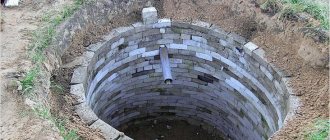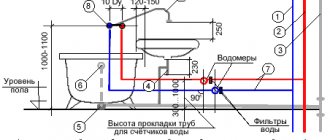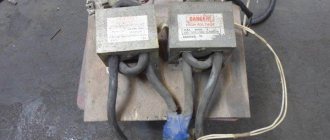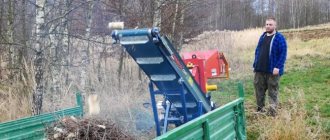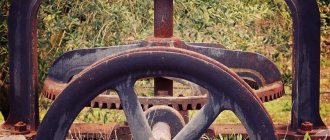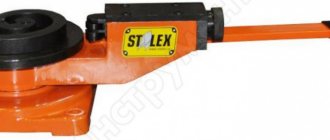Glued laminated timber has found widespread use in the construction of economy-class housing and luxury houses. In addition to house construction, small batches of material are used to implement original projects for the creation of architectural miniatures, interior decoration and furniture manufacturing. For these purposes, rare wood is best suited; blanks of non-standard sizes and original profiles may be required. You can make a unique profiled beam with your own hands for the implementation of individual author’s projects in your own workshop or on rented equipment.
Before organizing your own production, you need to decide whether independent production will be justified. The motivation for making such a decision is often the desire to realize one’s own creative potential in the following areas of business activity:
- Production of exclusive furniture;
- Providing services in interior design of homes;
- Author's design of reception halls, restaurant interiors and art exhibitions;
- Business in the field of architectural miniatures.
A dream to finish the facade of a house or arrange a veranda according to your own design can motivate you to make your own laminated laminated timber.
Depending on the needs for material and available woodworking equipment, there are several ways to independently produce profiled timber. The implementation of such a project includes the main stages:
- Defining goals, quantity of products and estimating the project budget;
- Selection of material and organization of drying;
- Production of lamellas;
- Gluing;
- Profile recess.
Characteristics of profiled timber
Types of profiled timber
Profiled timber is a modern building material, the production of which uses coniferous trees: pine, spruce or cedar. The surface of the material is ground, which ensures its almost perfect smoothness.
The profiled product is manufactured using new modern technologies.
It is given a unique tongue and groove shape. Thanks to this, the wood fits tightly against each other, which increases the thermal insulation of the erected structure.
Advantages when building from profiled timber
The advantages of building from profiled timber are as follows:
Construction of a house from profiled timber
- the product has an ideal hermetic shape, so various protrusions, depressions, etc. will not spoil the appearance of the building being constructed;
- the product has precise linear dimensions, making assembly of the structure easy and quick;
- the tight fit of the wood to each other provides increased thermal insulation of the room and protects it from moisture penetration inside;
- there is no need to organize a heavy foundation; you can get by with a strip or column base;
- the attractive appearance of the profiled structure allows you to abandon the exterior and interior decoration of the room;
- The use of profiled laminated timber or chamber drying during construction will save time for shrinkage of the room.
The use of a profiled element in construction helps to avoid problems such as the formation of cracks, cracking, and expansion of inter-crown seams, so there is no need to caulk the cracks.
The locking connection system allows even non-professionals to build structures from profiled timber.
Imitation as a decorative finishing option
Quite often, to create a certain style or interior atmosphere in the interior of a house, imitation timber is used with your own hands. This approach makes it possible to achieve an almost complete visual analogy with real timber and has a number of advantages:
Exterior finish with imitation timber
- Imitation can be performed on a surface made of any material;
- Wood consumption is significantly reduced, and, accordingly, financial costs and time for implementation;
- Such finishing can be done after the construction of the house at any time, both inside and outside.
It is quite easy to make a set of decorative elements for such an imitation at home. To do this, you will need a pre-calculated volume of boards with a thickness of at least 50 mm, as well as an electric plane and a sander.
The manufacturing process will be as follows:
- Using a plane, you need to smoothly round the edges of one of the sides of the board, giving it the rounded shape that a beam has;
- Then, using a sander, you should sand everything thoroughly, removing all the blemishes and marks from the plane.
A board processed in this way can very realistically imitate not only timber, beams and ceiling beams. To achieve complete similarity, in the corners where the planes of the walls meet, the boards must be shifted relative to each other by half their width, simulating cutting the corner of a log house.
If desired, such a “timber” can be tinted to resemble valuable wood species, further enhancing the imitation effect.
Classification of building element
During production, such products are classified according to the following criteria:
- structure;
- dimensions;
- profile type;
- degree of humidity;
- external view.
The profiled building element comes in the following dimensions:
Dimensions and sections of profiled timber
- 100x100;
- 150x150;
- 200x200.
For the construction of residential structures, products with dimensions of 100x100 are usually used.
According to their structure, the following varieties are distinguished:
- laminated veneer lumber;
- made from solid logs;
- double material that has increased thermal insulation.
The material is classified by shape as follows:
- rectangular;
- D-shaped.
Classification by profile type:
- with one spike;
- with two spikes;
- with beveled bevel;
- with a comb, i.e. with a large number of thorns;
- Finnish profile with wide grooves located at the top and bottom.
Finnish profile
When constructing residential buildings, wood with a Finnish profile or comb is usually used.
This choice is explained by the fact that structures made from it are erected faster and are more reliable than structures made from other materials.
Based on humidity level, the following types are distinguished:
- naturally dried;
- dried in a special chamber.
For the construction of premises, experts advise using chamber-drying products. The fact is that they are carefully selected, this allows us to supply only high-quality raw materials to the market. If the wood has dried naturally, it may become deformed or crack. But such products also enter the construction market. Therefore, experts recommend asking the seller how exactly the timber was dried before purchasing the product.
How to make profiled timber with your own hands, saving money?
There are several options for making profiled timber from ordinary timber, which allows you to save money and obtain higher quality material for construction. All you need is a little patience and free time, as well as the ability to handle some tools.
Many people ask questions: “Is there any point in making profiled timber with your own hands?”, “Maybe it’s easier to buy a ready-made one?” Of course, buying ready-made material is much easier. However, there are many reasons why the production of profiled timber is especially important:
Which profile is better?
When choosing a profile, it is better to calculate your skills and strengths. Making a profile on a block on your own seems like a simple matter. It takes a lot of perseverance and time to carry out such a task more efficiently. When choosing a profile, you should focus on the simplest designs. To implement them, you don’t have to use many types of tools and you don’t have to do a lot of calculations.
It is important to understand that before making a profile, you need to calculate its height, depth and width. Moreover, for each section of timber it is different and GOST helps. Be that as it may, when building a house from this timber, insulation (at least 5 cm thick) is laid between it.
How to make profiled timber with your own hands: methods
This is perhaps the easiest way. The milling cutter must be powerful, at least 1.5 kilowatts, and have a special attachment. If the profile is simple, then the radius of the cutter used will be 4-5 cm. If it is complex, then it is produced by several types of cutters. If desired, you can even make a D-shaped side of the beam with this tool. But here you will also need an electric planer and a sander.
But this option also has disadvantages:
Well suited for cutting straight grooves.
A good way to make the connection yourself is to use the tools at hand. For example, using a hand-held circular saw. Such a tool will cost you 3-5 thousand rubles (the price depends on the manufacturer). The main thing is that it can be sawed at the required angle and make a cut of 65 mm.
Advantages of this method:
Flaws:
It is best to use it to cut out a triangular groove.
In both options, this is painstaking and lengthy work that requires preliminary measurements and accuracy.
Of course, you can successfully combine these tools with each other. For example, if you need to make a rounded quarter, first cut it with a saw and then round it with a router. Do not rush to throw away sawing waste, as it will be useful for joining the timber.
All connections are made in accordance with GOST 30974 - 2002. As for the choice of cutting bowls, here you need to build on your own knowledge and skills.
Tools you will need: a milling machine or chainsaw with a special device, marking templates, a pencil, an axe, a tape measure and a hammer drill. A hammer drill is used to drill holes for dowels.
Two-way or one-way connection
With a double-sided connection, the bowl is cut out on both sides; with a one-sided connection, the bowl is cut out on one side.
At the end of the beam, it is necessary to measure a distance in width equal to the width of the beam, and in depth - half the section. Making such a connection will not be difficult. Next, the beams are stacked on top of each other. This connection is often called “cold”. This design requires at least 5 cm of insulation.
Connection in a “warm corner”
It should be said right away that it is not easy to do. This requires precision and special skills. But a warm corner is able to retain heat better and allows you to make the corners smoother.
There are several types of “warm corner” connections that you can make with your own hands: a connection with a main tenon, a keyed connection.
Make templates according to which the timber will be marked. For example, you can make it from wooden slats. Next you need to attach a template and make 3 cuts with a chainsaw to the required depth. Next, use an ax to chop off the excess along the cut. Protect the finished groove. It is important that the cuts have a large size, namely, they are half the cross-section of the original material. Thus, it compensates for them during the shrinkage of the house.
The tow is placed tightly between the joints. Caulking the “warm corner” after installation will be much more difficult. Using metal or wooden dowels, connect the crowns. Wooden dowels are made from the remains. When drying the timber, the iron pins will be visible, which will spoil the aesthetic appearance.
Wooden dowels are made with a diameter of 20-30 mm, sharpening them on one side. If you do them earlier, they will dry out by the time of construction. You can also make square dowels, which will be even easier to make. Moreover, its diagonal should be 4-6 mm larger than the diameter of the drill used. The length of the dowel should be equal to 1.5 times the thickness of the timber. When drilling holes, you need to take this size into account, but add another 2 cm.
You should not drill them near corner joints, since chips may form when hammering in the dowels. Such holes must be located in increments of 1.5 m and at a distance of 250 mm from the end.
It will be difficult to make such a warm corner yourself, especially the first time. This requires skills and ability to work with timber. However, if you have time left, you can practice on a thick board or old material.
Manufacturing of timber
Compensation cut
The production of profiled timber is carried out in several stages. To begin with, the forest is sorted, only high-quality wood that has no defects is selected. Next, calibration is done according to the dimensions of the material section and a compensation cut is made. It is this that prevents cracking during drying and shrinkage of the structure. Then the product is moved to the machine, processed on four sides and polished.
After this, a profile and bowls are made to connect the beams at the corners. This is done in cases where the manufacturer creates a kit for erecting a structure. In this case, all beams are tested for the quality of the connection. They are collected and looked at how tightly they fit together. Products with poor quality adhesion are rejected.
During the last process of timber production, the product is placed in a special device - chamber drying. This is where all excess moisture evaporates. Sometimes the production steps are reversed and drying is done first and only then calibration is done.
For better production, timber is treated with an antiseptic. But manufacturers often ignore this. Therefore, you should ask the seller about the availability of antiseptic treatment for the profiled element.
The production of laminated veneer lumber is slightly different from the production of other timber:
Glued laminated timber production technology
- first, the production of lamellas from prepared wood is carried out;
- selection of quality material;
- treatment of lamellas with antiseptics and fire retardants;
- connecting the lamellas using a special glue, which is applied along the entire length;
- making a lock connection;
- finishing and varnishing, if this process is provided for by production.
Warm timber
The production of warm timber is also taking place. In this case, there is one caveat - the internal slats are replaced with extruded polystyrene foam.
Using warm timber to build house walls
Some people planning to build a house believe that it is more advisable to produce profiled wood with their own hands. This is only relevant if a large-sized structure is being built, the area of which is more than 250 m2. The fact is that the production of such products will require special equipment. Its cost will pay off if a large amount of material is produced. If you still have a firm decision to engage in independent production of this type of wood, then you should purchase or rent a machine that has the following functions:
- cultivating the material using a multi-saw method, i.e. all four sides of the log are processed simultaneously;
- planing, grinding and profiling of material;
- making bowls of various varieties.
You can do without a machine in production if you have planed wood. In this case, you can make the necessary products from planed timber using a circular saw or cutter. With these tools you can easily make locking connections typical of profiled timber.
Corner beam connection
You can also make the corner connection of the timber yourself. Most often it is made in two types:
- One way or two way simple connection.
- Connection in a warm corner.
Any connection is made in accordance with GOST 30974 - 2002. You need to choose the type of cutting of bowls based on your own skills and knowledge.
The tools you will need are: a chainsaw or a milling machine with a special device, a pencil, marking templates, a tape measure, an ax and a hammer drill. Using a hammer drill, holes are drilled for the dowels.
One-way or two-way connection
With a one-sided connection, a bowl is cut out on the beam on one side; with a double-sided connection, the bowl is cut out on both sides.
At the end of the beam you need to measure a distance equal in depth to half the section and a width equal to the width of the beam. Cutting out such a connection is not difficult. Then the beams are stacked on top of each other. This connection is also often called “cold”. This design requires insulation and a layer of insulation of at least 5 cm.
Complex connection in a “warm corner”
Connecting to a “warm corner” is difficult to accomplish. This requires special skills and precision. Although a warm corner retains heat better and makes it possible to make the corners more even.
Advantages and disadvantages
Profiled timber has many advantages over other materials:
Comparative characteristics of solid and laminated timber
- attractive appearance of products;
- environmental friendliness - it does not harm human health;
- low thermal conductivity; if you use such material during construction, the room will always be warm;
- low cost, which is several times less than the price of other products made from untreated wood;
- low consumption of material during construction of the structure;
- the beams allow air to pass through, which ensures low humidity indoors.
In addition to its advantages, profiled timber also has disadvantages.
If the product was poorly dried during production, and it was installed at the base of the structure, then after some time it will sag, which will cause the need for repairs and additional costs.
The walls turn out to be very thin, and because of this, it can be cold inside the structure in winter, so the use of profiled timber in the construction of a residential building requires additional insulation of the walls.
The material has a high degree of flammability, which necessitates its treatment with a special composition that prevents the occurrence of fire.
After the construction of the structure, it will be impossible to make any redevelopment or extension.
Rules for selecting a profiled element
House made of profiled timber
To avoid problems with construction, you need to choose only high-quality building materials. Experts recommend purchasing profiled timber from the manufacturer. In this case, you can get acquainted with the production process and look at the already erected structures.
In addition, the manufacturer has the opportunity to order products with the required dimensions. Since a corresponding contract is concluded upon purchase, if a defect is discovered, you can file a claim with the seller, return the product and get your money back, or exchange the product for similar ones, but without defects.
When choosing a manufacturer, you should pay attention to the location of the plant and check all documentation. There must be quality certificates, appropriate permits and licenses. It is recommended to read reviews about the production on the Internet.
Profiled timber is a material that simplifies the construction of premises and reduces the time of its shrinkage. It has many positive characteristics, which is why today it is in great demand among developers.
What types of profiles are best to make?
When choosing a profile, it is best to calculate your strengths and skills. Making a profile on a beam with your own hands seems like a simple matter. It takes a lot of time and perseverance to carry out this task efficiently.
When choosing a profile, it is best to focus on the simplest designs. To implement them, you don’t need to use many types of tools and you don’t need to do a lot of calculations.
There is GOST 9330-76 “Basic connections of parts made of wood and wood materials.” This document will help you decide and calculate everything correctly. Basically, when profiling with your own hands, you make the following types of profile:
- Profiling through a block.
- Profiling through triangles.
You need to understand that before making a profile, you need to calculate its depth, height and width. It is different for each section of timber, and GOST will help with this. In any case, when building a house from such timber, insulation with a thickness of at least 5 cm is laid between it.
